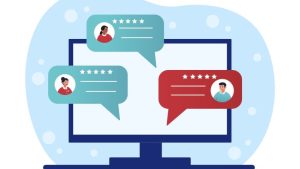How Gamification in the Workplace Can Help Alleviate Remote Worker Burnout
 Publié le 6 March 2024
Publié le 6 March 2024
Help improve the overall well-being of your colleagues by understanding how gamification in the workplace can help alleviate remote worker burnout.
In just the last five years, the workplace has seen big changes to the way it operates. Hybrid working is the new norm, with 80 million people across the United States alone engaging in some form of flexible employment.
This has meant that organizations have had to embrace digital technologies and develop new strategies in order to improve work experiences and keep remote employees feeling involved and engaged.
Enter gamification, a new technique in the corporate playbook to motivate employees and refresh day-to-day and routine tasks. Gamification involves the application of typical game-playing elements and competition to other areas.
In the business world, this means introducing elements of gameplay to situations like onboarding, collaboration and teamwork exercises, project management, brainstorming, sales, employee wellness, and more.
Read on to learn more about how gamification in the workplace can alleviate the burnout of remote workers and encourage productivity.
Free to use image sourced from Unsplash
What Is Gamification?
Put simply, gamification is the process of using games and game techniques in the workplace to encourage engagement with job tasks and make them more fun and productive. Game mechanics can provide continuous real-time feedback and a platform for ongoing skill development.
Game experiences can support human motivators with rewards and social connections, so they’re a great resource to spur on remote teams.
A 2022 survey by the Entertainment Software Association concluded that 97% of Americans view games as beneficial in some way, and 87% believe them beneficial for building skills.
Businesses have been keen to tap into this appetite for gaming in order to provide a good employee experience. Incorporating gaming into a training environment can make the whole process more enjoyable and can build a more engaged remote workforce.
Game-based learning/training is one example of gamification in the workplace, but it can be incorporated in lots of ways to engage and destress employees. For example, with goal-tracking schemes, interactive leaderboards, company competitions and reward badges, and leadership development programs among others.
Organizations can also leverage innovative solutions like Projectpro, which offers business solutions using big data, to enhance the gamification experience for their remote workforce.
What Are the Benefits of Workplace Gamification for Remote Workers?
Gamification is a powerful tool through which to reinvigorate remote teams and ensure their productivity through some friendly competition. It has several benefits.
Improves the digital work environment
A healthy work environment tends to increase employee satisfaction and retention, boosting productivity. The same is true for the digital workplace. Gamification can help employees demonstrate their value to the company while excelling at certain tasks, meeting quotas, and obtaining visibility through platforms like online leaderboards.
Reduces stress
Games are proven to help reduce anxiety. So, it makes sense to introduce gaming to help minimize employee anxiety and stress. When used effectively, gamification can foster a sense of community among players and promote positive thinking. They can be a way to help your workforce relax and have fun, but they can also be effective at managing tasks.
For example, you might introduce games for planning and time management. A work schedule maker can be gamified by defining goals and setting rewards while at the same time improving staff organization.
Offers real-time feedback
Gamification offers real-time measurable feedback for your remote workers. Instead of waiting for annual reviews, they can check up on their performance in an instant.
This means that employees can track their progress and identify any gaps and areas for improvement immediately. Certain gamification models can also allow teams to set goals and visually track progress towards these with graphic control elements like progress bars and meters.
With remote work burnout on the rise, it’s crucial to provide instant and measurable incentives and let employees know when they’ve met their targets so they can take some well-earned time off.
Free to use image sourced from Pixabay
Promotes advocacy
Gamification gets people talking about your company and boosts your image. Implementing modern technologies into the workplace helps younger generations of employees engage in traditional work practices like training and allows information to be digested in engaging visuals and animations. Feeling more involved, they are more likely to advocate for your organization and speak of its benefits of positive values.
You can also gamify advocacy programs themselves by providing leaderboards and incentives for leaving positive employee reviews, commenting on social media posts, watching videos, etc. Employee engagement is undergoing a digital transformation.
To stay relevant, organizations need to do all they can to adopt online methods and use digital tools for work tasks whenever possible.
Improves teamwork
When it comes to remote workers, it can be a challenge to bring teams together without a common workplace. Gamification helps to solve this issue by allowing employees to join forces towards common goals. Incorporating elements of both competition and gaming encourages communication amongst your team as well as skill development and trust building.
There are a plethora of games available online for the purpose of online team building. From wherever employees are based, they can interact with their teammates and communicate daily. Invest in tools like a remote management solution to oversee team events with access to all the remote devices on your network.
Makes the mundane enjoyable
Telecommuting can make the workday quite lonely and monotonous, so it’s important that employers implement strategies to help alleviate burnout and boredom from long-term remote work. Gamification can take mundane day-to-day tasks and create enjoyable competitions and challenges.
Adding a sense of purpose or competition to repetitive tasks makes them more engaging and rewarding. It can also give remote employees a greater sense of ownership over their work by allowing them a larger say over how they complete daily tasks and providing immediate feedback.
Free to use image sourced from Unsplash
How to Use Gamification to Keep Employees Engaged
When it comes to remote work, in particular, teams can find it a challenge to stay motivated and engaged. Games make work more enjoyable, so employees are more likely to put effort into their tasks and stay with your company for longer. It can be applied to many areas. Knowing how gamification in the workplace can help alleviate remote worker burnout can lead to more engaged employees and better work as a result.
Recruitment and onboarding
Gamification has the ability to transform every HR duty into an interactive process for potential new recruits. By introducing game-like features such as challenges, online competency tests, and more, candidates become actively engaged in the recruitment process.
What’s more, their interaction with gamification features can give your human resources team greater insights into their characters and how they might mesh with your current employees.
For onboarding and orientation, interactive challenges and storytelling can be used to engage new hires. A quick online search will bring up multiple different providers of smartphone-style online onboarding gamification tools that can be accessed via desktop or iPhone remote access for telecommuters.
These tools can help organizations streamline their agile recruitment process by providing fun games and activities to make training more enjoyable, encourage friendly competition among recruits, and recognize early achievements.
Each of these works well to provide fun games and activities to make training more enjoyable, encourage friendly competition among recruits, and recognize early achievements.
Free to use image sourced from Unsplash
Performance reviews and employee wellness
The ability for remote workers to monitor their work performance in real-time and on an ongoing basis really sets gamified performance reviews apart from traditional annual systems.
With an online game mechanic, there can be a continuous feedback loop between the company and its employees. This also means that more short-term goals can be set and instantly monitored, making for more immediate results.
A key benefit of gamification is its instantaneousness. Just as this applies to performance reviews and rewards, it is also really valuable for employee wellness. Here, health habits and goals can be shared among co-workers and rewarded by higher-ups.
Employees can also work towards goals collectively, despite potentially being in different time zones and locations, using remote control software. All this helps to promote a culture of teamwork and unity.
Customization
The day-to-day operations of a company will vary depending on its business. While gamification has a clear benefit, it needs to be implemented in different ways depending on the nature of the team it intends to help. For example, a team of sales reps will be motivated by different rewards to call center service providers.
Games should be tailored based on their intended audience and should provide incentives that will encourage workers to put their all in.
Moreover, for businesses involved in creative fields like art, design, or craftsmanship, customizing gamification strategies can be particularly valuable. For instance, for artists looking to promote their work and connect with potential buyers, integrating gamified elements that enable them to showcase and sell art online can be a creative and engaging approach.
Another way to use customization is to allow employees to personalize their gaming experience. This can be with things like custom avatars, profiles, and user interfaces.
Free to use image sourced from Unsplash
The Future of Gamification
One thing’s for sure: gamification in the workplace is here to stay. Just recently a Lucas Systems survey of over 750 employees determined that 84% of its respondents were more likely to stay with a company if it developed the gamification of day-to-day tasks.
With burnout a yet more common phenomenon among remote workers, it makes sense that gamification is something that could keep this subset of employees engaged, energized, and loyal.
Game-based incentives and rewards can be a powerful motivating tool when used effectively. They make for an extra productive and fundamentally more enjoyable work environment. As more and more companies explore the benefits of game-based recruitment, training, and more, it becomes crucial to join them and not be left behind. It’s important for companies in all sectors to consider how gamification in the workplace can help alleviate remote worker burnout.
Modern remote employees want to work for companies on the cutting-edge, that care about their well-being, and take initiatives to keep them content and engaged. Implementing gamification today ensures your employee retention remains high and your productivity is supercharged.







